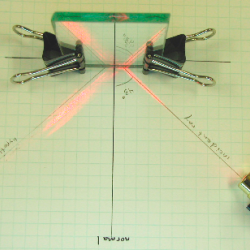Source Institutions
Source Institutions
Add to list Go to activity
Activity link broken? See if it's at the internet archive

In this activity, learners test the Law of Reflection based on experimental evidence. Learners produce raw data and explanations based on their data: pencil tracings of incident and reflection rays. Then, learners relate their knowledge of mirrors and laser to understanding how astronomical telescopes use curved mirrors to focus star light onto electronic detectors.
- Under 5 minutes
- 45 to 60 minutes
- $1 - $5 per group of students
- Ages 14 - 18
- Activity, Experiment/Lab Activity, Lesson/Lesson Plan
- English
Quick Guide
Materials List (per group of students)
- pen and pencil
- laser pointer
- 2 binder clips
- 1 flat back-silvered mirror, 1/4 inch thick
- letter size (8.5 x 11 inches) graph paper
- 1 protractor
Subjects
-
Earth and Space Science
-
Astronomy
- Probes, Satellites and Spacecraft
-
Astronomy
-
Physical Sciences
-
Light and Optics
- Lasers
- Lenses and Mirrors
- Reflection and Refraction
-
Light and Optics
-
Engineering and Technology
-
Engineering
- Aerospace Engineering
- Technology
-
Engineering
-
Mathematics
-
Data Analysis and Probability
- Data Analysis
- Data Collection
- Data Representation
-
Geometry
- Plane Geometry
-
Data Analysis and Probability
-
The Nature of Science
-
The Scientific Process
- Conducting Investigations
- Gathering Data
- Formulating Explanations
- Communicating Results
-
The Scientific Process
Audience
To use this activity, learners need to:
- see
- read
- touch
Learning styles supported:
- Involves teamwork and communication skills
- Involves hands-on or lab activities
Other
Components that are part of this resource:
Includes alignment to state and/or national standards:
This resource is part of:
Access Rights:
- Free access
By:
- The University of Texas McDonald Observatory
Rights:
- All rights reserved, The University of Texas McDonald Observatory, 2011
